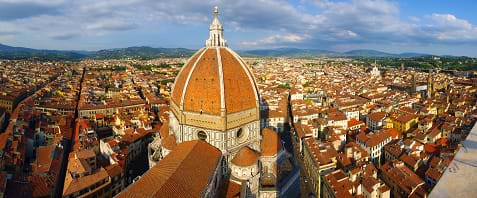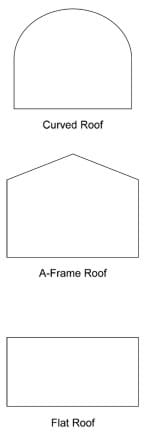Quick Look
Grade Level: 1 (K-2)
Time Required: 45 minutes
Expendable Cost/Group: US $1.00
Group Size: 1
Activity Dependency: None
Subject Areas: Science and Technology
NGSS Performance Expectations:

| K-2-ETS1-2 |
| K-2-ETS1-3 |
Summary
When you look around your neighborhood, what do the roofs look like? What if you lived in an area with a different climate, how might that affect the style of roofs that you see? Through this introductory engineering activity, students consider the advantages of different roof shapes for different climates or situations. During a teacher demo, they observe and discuss what happens when a "snow load" (sifted cups of flour) is placed on three different model roof shapes. A student worksheet is included.
Engineering Connection
Civil engineers always consider the climate of the area in which they plan to design and build structures. They consider the types of natural disasters that the area is prone to having. The design and materials chosen for a building's roof help to maintain the desired temperature within the building and provide a stable structure to protect against the local weather conditions. Engineers use models to test the shapes, materials and functionality of their designs.
Learning Objectives
After this activity, students should be able to:
- Understand that materials, both natural and human-made, have specific characteristics that determine their suitable use.
- Understand that engineering design requires creative thinking and consideration of a variety of ideas to solve practical problems.
- Explain why climate and natural disasters have an impact of how engineers design buildings and structures.
Educational Standards
Each TeachEngineering lesson or activity is correlated to one or more K-12 science,
technology, engineering or math (STEM) educational standards.
All 100,000+ K-12 STEM standards covered in TeachEngineering are collected, maintained and packaged by the Achievement Standards Network (ASN),
a project of D2L (www.achievementstandards.org).
In the ASN, standards are hierarchically structured: first by source; e.g., by state; within source by type; e.g., science or mathematics;
within type by subtype, then by grade, etc.
Each TeachEngineering lesson or activity is correlated to one or more K-12 science, technology, engineering or math (STEM) educational standards.
All 100,000+ K-12 STEM standards covered in TeachEngineering are collected, maintained and packaged by the Achievement Standards Network (ASN), a project of D2L (www.achievementstandards.org).
In the ASN, standards are hierarchically structured: first by source; e.g., by state; within source by type; e.g., science or mathematics; within type by subtype, then by grade, etc.
NGSS: Next Generation Science Standards - Science
| NGSS Performance Expectation | ||
|---|---|---|
|
K-2-ETS1-2. Develop a simple sketch, drawing, or physical model to illustrate how the shape of an object helps it function as needed to solve a given problem. (Grades K - 2) Do you agree with this alignment? |
||
| Click to view other curriculum aligned to this Performance Expectation | ||
| This activity focuses on the following Three Dimensional Learning aspects of NGSS: | ||
| Science & Engineering Practices | Disciplinary Core Ideas | Crosscutting Concepts |
| Develop a simple model based on evidence to represent a proposed object or tool. Alignment agreement: | Designs can be conveyed through sketches, drawings, or physical models. These representations are useful in communicating ideas for a problem's solutions to other people. Alignment agreement: | The shape and stability of structures of natural and designed objects are related to their function(s). Alignment agreement: |
| NGSS Performance Expectation | ||
|---|---|---|
|
K-2-ETS1-3. Analyze data from tests of two objects designed to solve the same problem to compare the strengths and weaknesses of how each performs. (Grades K - 2) Do you agree with this alignment? |
||
| Click to view other curriculum aligned to this Performance Expectation | ||
| This activity focuses on the following Three Dimensional Learning aspects of NGSS: | ||
| Science & Engineering Practices | Disciplinary Core Ideas | Crosscutting Concepts |
| Analyze data from tests of an object or tool to determine if it works as intended. Alignment agreement: | Because there is always more than one possible solution to a problem, it is useful to compare and test designs. Alignment agreement: | |
Common Core State Standards - Math
-
Reason with shapes and their attributes.
(Grade
1)
More Details
Do you agree with this alignment?
International Technology and Engineering Educators Association - Technology
-
Illustrate helpful and harmful effects of technology.
(Grades
Pre-K -
2)
More Details
Do you agree with this alignment?
-
Explore how technologies are developed to meet individual and societal needs and wants.
(Grades
Pre-K -
2)
More Details
Do you agree with this alignment?
-
Apply design concepts, principles, and processes through play and exploration.
(Grades
Pre-K -
2)
More Details
Do you agree with this alignment?
-
Illustrate that there are different solutions to a design and that none are perfect.
(Grades
Pre-K -
2)
More Details
Do you agree with this alignment?
State Standards
Massachusetts - Math
-
Reason with shapes and their attributes.
(Grade
1)
More Details
Do you agree with this alignment?
Massachusetts - Science
-
Analyze data from tests of two objects designed to solve the same design problem to compare the strengths and weaknesses of how each object performs.
(Grade
2)
More Details
Do you agree with this alignment?
Materials List

- 3 shoeboxes or similar containers
- 1 poster board
- 1 newspaper and/or cookie sheet
- ~2 cups flour
- (optional) flour sifter or sieve
- Roof Shape Worksheet, one per student
Worksheets and Attachments
Visit [www.teachengineering.org/activities/view/which_roof_is_tops] to print or download.Introduction/Motivation
What shape is the roof on your house? What is the climate where you live? Can you think of reasons why the climate might influence the shape of your roof?
Ask students what type of natural disasters can affect the shape of your roof. Elicit responses from students. Explain that snowstorms and blizzards have a large influence on the shape of your roof because of the weight of the snow. Architects and engineers who design homes in regions that get a lot of snow think about how snow builds up on the roofs. If a roof is not strong enough, the weight of the snow (the "snow load") may cause the roof to cave in.
Today you are an engineer designing a roof for a snowy climate. What roof shapes would you consider to prevent snow from building up on the roof? What types of materials would you use to build your roof to help prevent snow from sticking to it?
Procedure
Background
A model is a copy of an object that is too big, too small or too complicated, costly or dangerous to study easily. Engineers use models to test and study how well things are built or to test different designs. To an engineer, a "load" is any force that pushes or pulls. For example, the weight of snow pushes down on a building, and that's what we call a snow load. A wind load pushes on the sides of a building and the structures of a bridge.
Before the Activity
- Gather materials. Obtain flour and containers to hold about 2 cups of flour. A flour sieve is helpful, if available.
- Make copies of the Roof Shape Worksheet, one per student.
- Gather a collection of photographs from the Internet that show different types of roofs in various climates to show the class.
- Create three model roofs for a class demo. Cut away one end of each box so that students can view the effects of snow loads. Use poster board to make three different roof types, one for each box: curved, A-frame and flat (see Figure 1 or the worksheet). Using a single piece of masking tape, tape each edge of the roof to the open top of the box. Place newspaper and/or a cookie sheet under the testing station to catch any loose flour (to control the mess and collect flour to use again in the next test).
With the Students
- Show the class photographs of different roof designs. Talk about what types of climates each roof might be found in. What characteristics make a roof good or bad for a given climate? Incorporate the Investigating Questions into the activity.
- Show the class the example roofs you prepared in advance. We call these models.
- Explain that the flour represents snow. Ask students to make predictions as to which roof would be best for a snowy climate.
- Slowly sprinkle "snow" onto the center of the roof as students watch the roof through the open end of the box.
- Have students make observations on their worksheets as the snow is applied to the roof and builds up to a weighty amount ("the snow load").
- Repeat the process with each model roof type.
- Conclude with a class discussion to share and compare observations and conclusions. Refer to the Investigating Questions.
Assessment
Questions: Throughout the activity, ask students the Investigating Questions to gauge their comprehension of the concepts. Refer to the Rubric for Performance Assessment for suggested criteria to assess their knowledge and understanding of the concepts.
Investigating Questions
- Predict: Which roof type will cave in to the snow load the easiest? Why?
- What happened to each model roof when a snow load was applied?
- Does the "snow" pile up or slide off? Is this different for different roof types?
- Which roofs sag? What does the sagging mean?
- Which roofs fall down? Do they fall slowly or all at once?
- Which roof design is "tops" for snowy climates?
- In addition to snow loads, what other forces should we plan for? (The forces of wind and rain and maybe even earthquake shaking; weight of shingles or tiles plus gutters and walking people; falling tree branches.)
- Which roof shaphe would you want if you lived in a snowy area? A windy area? Rainy?
- What roof styles, shapes and materials are best for which climates and weather conditions?
Troubleshooting Tips
To avoid a flour storm after done loading one roof type, carefully lift the roof and gently tap the bottom so that the flour falls into the box. Empty the flour from the box into a container to be reused for the next test.
Subscribe
Get the inside scoop on all things TeachEngineering such as new site features, curriculum updates, video releases, and more by signing up for our newsletter!More Curriculum Like This

Students learn about some of the different climate zones in China and consider what would be appropriate design, construction and materials for houses in those areas. This prepares them to conduct the associated activity(ies) in which they design, build and test small model homes for three different...

Students are introduced to the primary types of erosion—chemical, water, wind, glacier and temperature. Students investigate examples of each erosion type and discuss how erosion changes the surface of the Earth.

Students learn about the types of possible loads, how to calculate ultimate load combinations, and investigate the different sizes for the beams (girders) and columns (piers) of simple bridge design. Additionally, they learn the steps that engineers use to design bridges.
Copyright
© 2013 by Regents of the University of Colorado; original © 2004 Worcester Polytechnic InstituteSupporting Program
Center for Engineering Educational Outreach, Tufts UniversityLast modified: January 6, 2023








User Comments & Tips